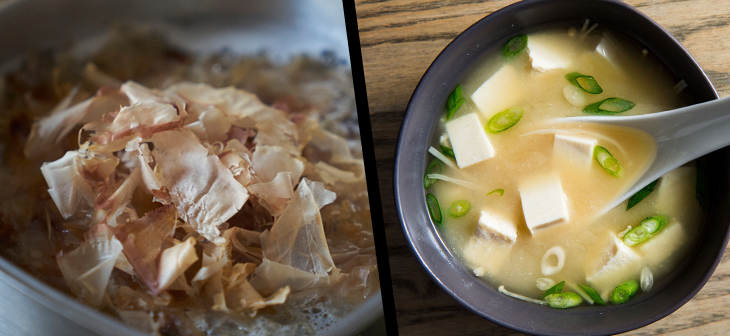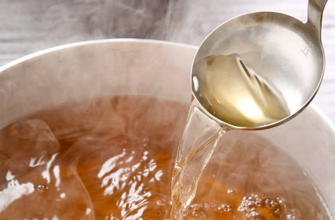Today, I want to share with you “how to cook basic miso soup”. There are only two basics to making a good miso soup. The first is to choose the right dashi stock and ingredients. And the second is to add the ingredients and miso at the right time. As long as you keep these two things in mind, anyone can easily make a delicious miso soup to their liking.
- To choose the right dashi stock and ingredients for miso soup
- To add the ingredients and miso at the right time
- Tips1 : Start with ingredients that are slow to cook
- Tips2 : Add ingredients that are easy to cook to the last
- Tip3 : Add fried tofu, which works perfectly any ingredient
- Tip4 : Turn off the heat and then add miso
- Information
- Ingredients
- Instructions
To choose the right dashi stock and ingredients for miso soup
In general, the best dashi for miso soup are bonito, kelp, and dried sardine.
When you go to Japanese or Asian supermarkets, you will find a variety of dashi available, including granulated dashi, additive-free powdered dashi, and the ingredients themselves, such as dried bonito flakes, kombu, and dried sardine.
However, do you know what dashi is anyway? Dashi is the “umami-flavor” that is transferred from the ingredients to the water. That’s why when you boil a number of ingredients in it, it has a delicious flavor on its own, and that is what dashi is.
There is no need to be constrained by the fact that bonito, kelp, and dried sardines are generally suitable for dashi. For example, there is the flavor from cabbage, pork, and ultimately miso. So, the best way to choose dashi is to “choose according to your taste.
A variety of ingredients can be used in miso soup, including vegetables, tofu, meat, and seafood. A single ingredient can be delicious, but if you add two or three different ingredients, you will get a good balance of flavors. Miso soup with lots of ingredients has enough nutritional value to be a side dish on its own. A good example is TONJIRU with lots of vegetables, konjac, fried tofu and pork.
To add the ingredients and miso at the right time
Tips1 : Start with ingredients that are slow to cook
For example, hard root vegetables such as carrots, radishes, onions, and potatoes should be added first. They will be cooked thoroughly to your desired firmness. The same goes for fish. Seafood is less likely to develop an odor if the water is first brought to a full boil before adding it. Simmering root vegetables and seafood also provides a flavorful broth. However, if you want to add shellfish, boil them slowly from water to get a good broth.
Tips2 : Add ingredients that are easy to cook to the last
Tofu, beaten egg, and seaweed do not need to be cooked for long. For ingredients that are easily cooked, add them to the boiling water and cook them quickly.
Tip3 : Add fried tofu, which works perfectly any ingredient
Fried tofu is a vegetable food derived from soybeans, but it also has a delicious oil flavor that adds a lot of depth when added to miso soup. For example, cabbage and fried tofu miso soup, bean sprouts and fried tofu miso soup, even a combination of vegetables will give you a rich taste. If you are not sure what to use, I highly recommend using fried tofu.
Tip4 : Turn off the heat and then add miso
One serving of miso is one tablespoon (about 15 grams). Make sure that the ingredients in the pot are well cooked before turning off the heat and adding the miso. After the miso is melted, do not leave it for a long time or bring it to a boil. If you boil the soup, the aroma of the miso will be lost!
Now, I will share with you how to make a basic miso soup using combined dashi stock made from bonito flakes and kombu.
Information
| PREP TIME: 5 mins | COOK TIME: 5 mins | TOTAL TIME: 10 mins |
| COURSE: Soup | CUISINE: Japanese | SERVINGS: 2 people |
Ingredients
- 400 ml dashi
- 1/4 cut tofu, bite sized
- 1/2 sheet fried tofu, sliced
- 1 spring onion, diagonal sliced
- 2 tbsp miso
Instructions
- Heat the dashi and bring it to a boil.
- Add all the ingredients and simmer over low to medium heat until cooked through.
- Once off the heat, ladle in the miso and let it melt in a small amount of boiling water. Melting the miso first in a ladle will prevent lumps. Also, be careful not to add the miso while the water is still boiling, as it will lose its flavor and taste and become salty.
- Cook over low heat until almost boiling. It’s done when bubbles appear and the liquid around the edges of the pan starts to boil.









